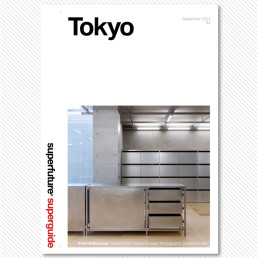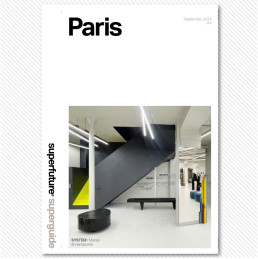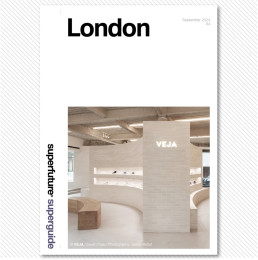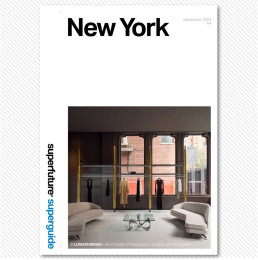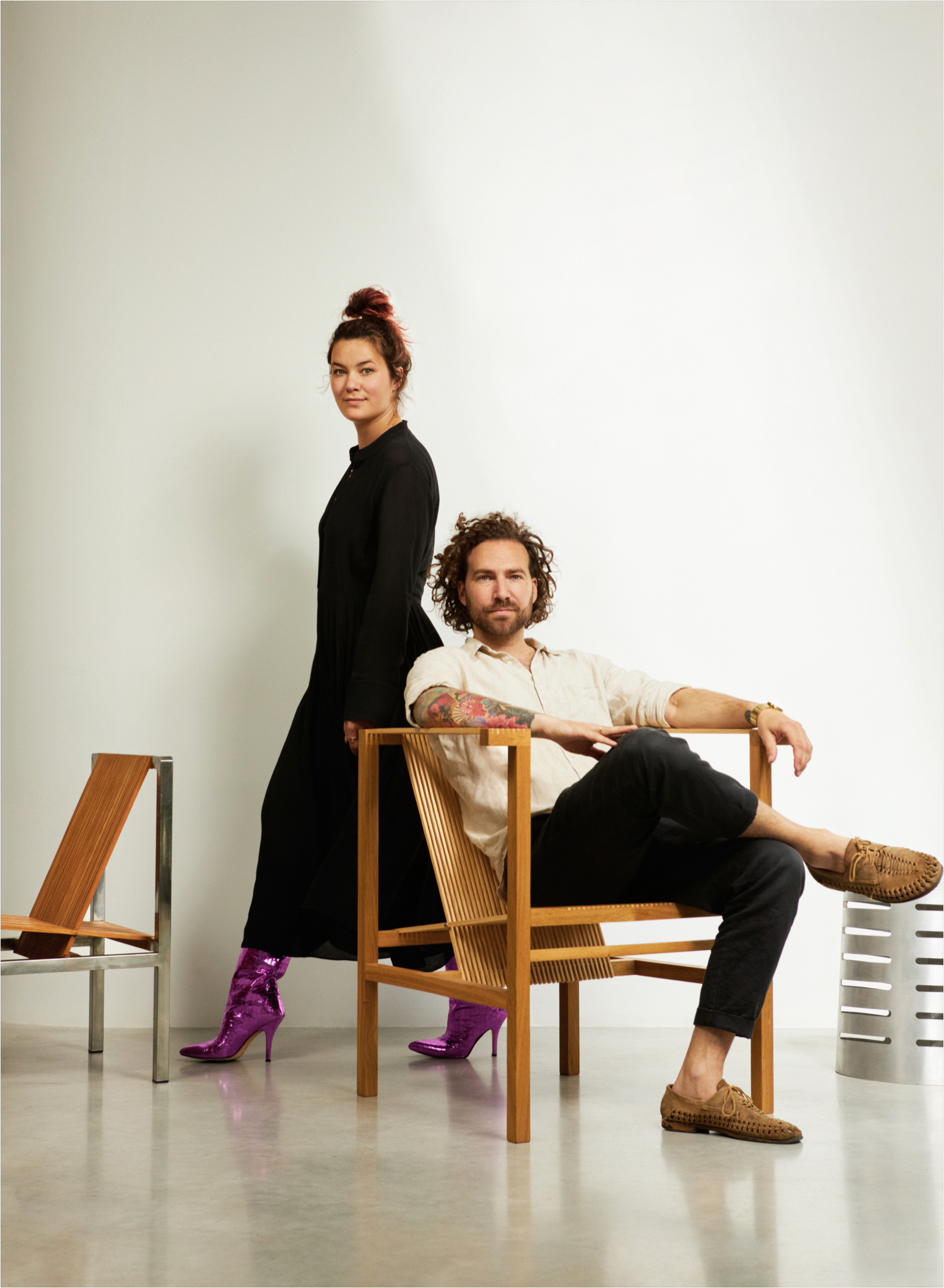
A blue chip off the old block. We’re talking Dutch print and fashion designer Romy Kokke who has teamed up with her former DJ and creative multi-tasker husband Daniel Beasley for a veritable passion project—reviving the underexposed and archive treasures of her father Ruud-Jan Kokke. The latter, an ArtEZ University of the Arts graduate and prolific furniture designer, has created an impressive legacy which, back in the day, undeservedly failed to gain the limelight. Immersed in her father’s designs while growing up, young Romy’s appreciation merely focused on their functionality, but growing up, and herself eventually being trained as a designer, the understated aesthetic put a spell on her. Newly established KOKKE House is a collaborative effort of Romy and Daniel, and, in fact, the entire Kokke family, to shed a new light on father Ruud-Jan’s archive, but also create new designs and provide a platform for the multi-disciplinary art and design of mother and artist Petra Hartman. Superfuture recently dropped by the duo’s idyllic countryside abode just south of Amsterdam to find out more about their passion project.
What made you decide to reissue the designs of your father / father-in-law?
RK: Actually, it’s something I always wanted to do, but each time the idea got sidetracked. Very early on, when I was around eighteen or so, I already valued of my father’s designs and simply wanted the world to know about it. You know, me and my family grew up with his designs without having a notion of monetary value, but we truly appreciated their stunning simplicity and quality. They’re also utensils, and at home we used them as such in our day-to-day life. So, the designs are very much a part of my family’s life.
DB: What’s so amazing about Romy’s family home is that it’s brimming with art and design furniture, all randomly mixed, and the furniture pieces have actually been used, and quite intensively so, serving their purpose and also proving durable they are. Some pieces have been in the family for decades and are very much intertwined with our personal lives. So, when we started KOKKE House, we already knew how very durable these designs were.
RK: However, how we got to starting this venture was difficult. What I was already doing in retail design was great, but I never designed something that would exactly be according to my taste, it was never really me, if you know what I mean. So, Daniel and I eventually set out to do something for ourselves—we share the same sense of aesthetic and agreed on which trajectory to follow, but also, we wanted KOKKE House also to include the work of my mother, sister and myself. It all grew organically, but for the actual kick-start of the company we sought advice, resulting in the re-release of my father’s F_21 chair.
DB: We’ve had this chair for years when we were still living in a small apartment in Amsterdam, but once we relocated to this bigger space in the countryside, quite surprisingly, friends suddenly started to notice its design. So, we realised the design is still very relevant and that it resonates with a new generation, and it’s such a shame it for sale anywhere. And then we found this box with beautifully documented designs by Romy’s father, of which some has never have seen the light of day. Drawings, slides, patent applications, quotations—it was all in there.
RK: We’ve got items which already exist, but there so much more we’d like to release, in addition to creating new designs. We’re really excited to show it all!
DB: It’s Romy who curates all designs, deciding which pieces will bear the KOKKE House mark.
RK: The curation is sheer gut feeling. There’s simply so much to choose from. So, you have to stay true to yourself to avoid becoming insecure by all these wonderful discoveries. But the more I’m delving into the designs and the work spawning from it, the more connected I feel. The designs have a very pure quality, which I love about it, and aren’t contrived or pretentious. And I want to show it all!
Could you elaborate on the branding of KOKKE House and the marketing strategy you’ve chosen to put the brand on the map?
RK: As said, I thought the designs were exceptional, but also needed to be dusted off in order to make them more ‘us’. I’m a print and fashion designer by trade myself, and on the one hand, I love anything outgoing, hysterical even – very similar to my mother – but I also like simplicity and no fuss, which is typically my father. Very contradictory, I know, but it’s very me.
DB: We wanted to do justice to the timelessness of the designs, but also wanted to emphasise that KOKKE House is a new brand at the same time. I consider some of the leading fashion houses as an inspiration source. They continuously churn out new collections, although that’s not what we’re aiming for, but they present an eye-catching couture line and additionally present ready-to-wear and diffusion lines. I see the F_21 chair as our very own couture piece, but we also could decide to release dinner table chairs derived from that design. Look at Louis Vuitton’s current collaboration with Japanese artist Yayoi Kusama, it’s that spirit we can very much identify with, and it’s a trajectory we’d like to pursue, integrating art and design. So, we aim to create spectacular designs with matching marketing presentations, but we also would like the offerings of KOKKE House to be accessible for a bigger market.
RK: And we’ll also include my mother’s artworks, such as this wall object here, this colourful carpet, and that tulip bouquet statuette. It’s this combination of works that’s important for me. Both my parents pretty much leave it all up to us, but we consult them quite often. We’ve already worked a lot with them both in different projects and also know each other well on a professional level. My father tends to think first before doing things, while my mother is a whirlwind of amazing ideas, and both are very valuable.
DB: Interestingly, Romy’s parents are both very autonomous workers who aren’t distracted by contemporary impulses or mindsets. They’ve always managed to retain a high degree of open-mindedness, and I think Romy has been able to capture that in her curation.
RK: I think their ideas are truly valuable and deserve to be put into action, but the way they work isn’t compatible with how it’s done today—you know, creating mood boards, assembling creative teams, all that.
DB: But it has been great fun to collaborate with them, being able to see and learn new things. And they love working with us too. I remember that initially they fully agreed with our plan, but had reservations regarding time because both have busy schedules. But it all turned out for the better and they’re very much involved. We even included Romy’s brother and sister in our activities, it truly is a family enterprise.
RK: So, the entire operations and marketing of KOKKE House we do ourselves, although we’re surrounded by several friends and other people who can advise us from time to time. But we did appoint an external press manager who has done quite a lot for us in terms of media, and it’s someone who’s proactive and very involved in developing a strategy. So, the showcases in Milan last year, and recently, in Paris came from us and both were very successful. This year, we’re looking for a different kind of exposure, such as the upcoming edition of the Object trade show in Rotterdam. We’ve secured a large space and intend to show off a lot of what we’ve got, such as our collaboration with renowned Dutch artist Klaas Gubbels.
Who does what within KOKKE House? Is the task set divided between the two of you or is there an overlap in activities?
DB: There certainly is an overlap. We make coordinated decisions, but it’s Romy who generally does all the creative stuff, and I take care of everything else, from business operations to logistics. But we do consult each other a lot about our own activities. By the way, everything is made in an atelier in the southern province of Limburg and is shipped from there although we also keep a stash of designs right next door from where we live. But we plan to open a showroom and store in Amsterdam in the not-too-distant future and move all our stock there. We’ve got some location options, but haven’t decided yet where to set up shop.
RK: We’d love to be able to show our designs and for people to immerse themselves in that KOKKE House feel.
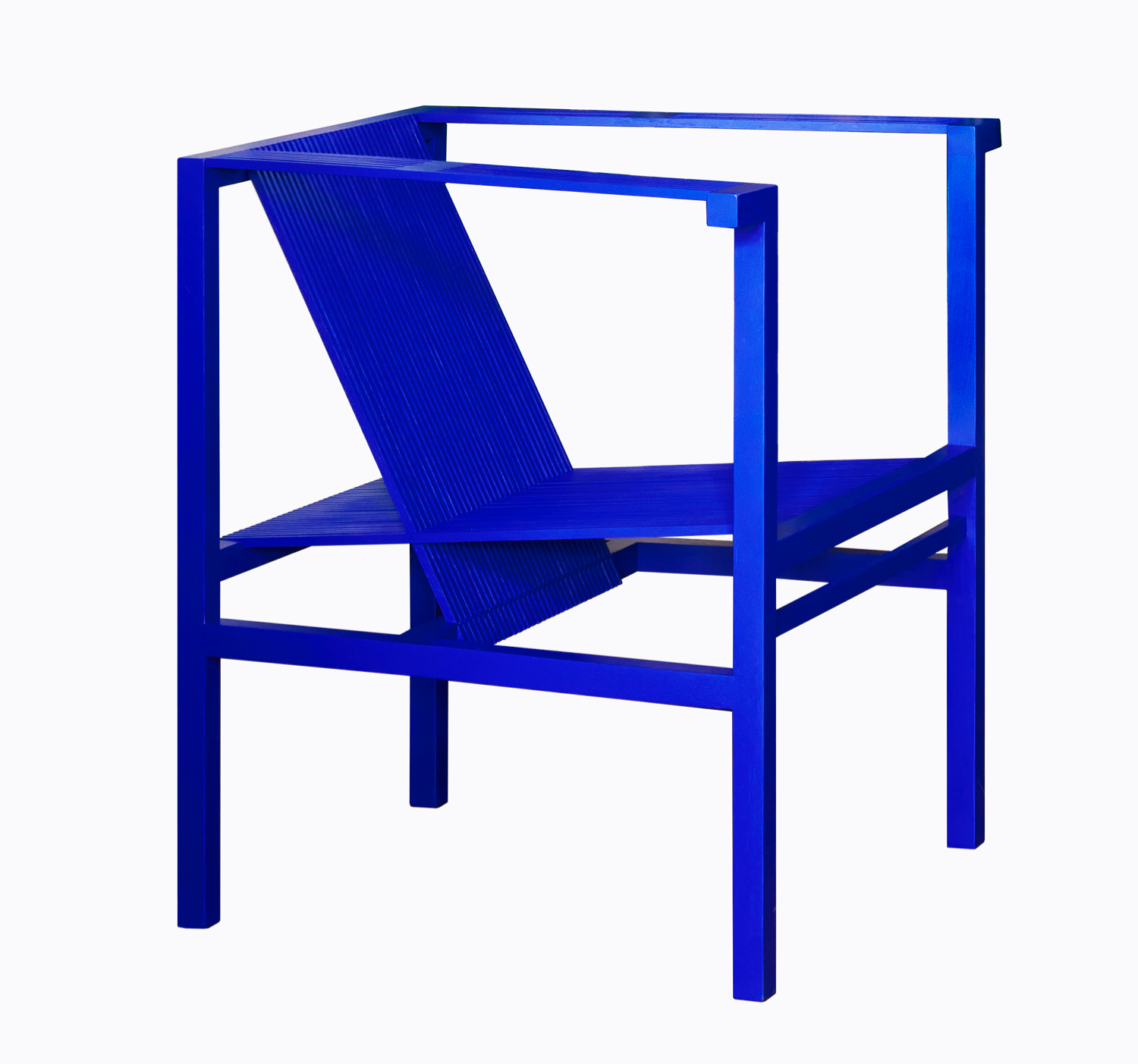
What’s the profile of the KOKKE House design aficionado?
DB: I think the demographic is predominantly one between 30 to 50 years of age, but I also see a particular group of true design aficionados, many are designers or craftsmen, and they could be any age. Particularly this group literally scrutinises the design, picking it up and firing lots of questions. But the majority of our clientele is somewhat older and established, and they truly appreciate good design. Many purchased this chair when it was first released, and all of a sudden, vintage editions started to pop up everywhere. The Louis Vuitton flagship store in London has a pair of C_40 chairs, featured in ELLE Decoration China, and designer Kelly Wearstler has one in her Miami abode which appeared in Vogue Korea. But these are all vintage pieces, Ruud-Jan Kokke only made 20 or 30 of them back in the day. Interestingly, the response of design aficionados abroad is totally different, almost as if they’ve just discovered a new Rembrandt, so to speak. They usually know all about the ‘classic’ Dutch designers such as Gerrit Rietveld and the pack of designers related to the Dutch Design wave in the early 1990s, and they’re blown away by the KOKKE House collection and that it preceded the aforementioned design wave. They totally loved it in Milan, and it felt as if people there instantly recognised the quality of the design.
How do you go about re-issuing pieces from your father’s archive? What’s the selection procedure like, and also, how big is the archive?
RK: Well, the archive contains hundreds of designs. For each item, my father created many variations. What you see here is a predecessor of the dining room chairs, and also the braided chair, the C_40, is accompanied by a table, a stool, a cupboard, and also has a dining room equivalent. It’s all beautiful, so what we’re doing right now is focusing on a small collection to reissue. You know, everything has been so meticulously drafted that we hardly have to do anything ourselves except for certain execution issues, but that I discuss with my father and Daniel.
DB: When Romy’s father designed this chair 30 years ago, the seat surface was smaller and also the seat height was lower. The average height, and also weight, of people has increased over time, so the design needed adjustments. We always consult Ruud-Jan and he’s very much involved in the production process. Whenever we introduce a new product he joins us to visit the atelier down south in Limburg for a thorough inspection, and that occurs with each batch that’s made there.
RK: For instance, this wooden kid’s chair that my father made was one of the first designs I wanted to reissue, simply because there’s no beautiful kid’s chair to be had, but these days, it’s impossible to do because of current safety regulations.
DB: We don’t want to reissue everything all at once. I believe we first have to create a certain demand. Besides, each design deserves a certain degree of exposure.
The work of Ruud-Jan Kokke is quite niche, and despite being included in collections of leading museums, it’s not very known. However, his work shows all the hallmarks of great design. Why hasn’t it caught on in his time?
RK: It’s a specific zeitgeist which was prevalent at time. My father told us that back in the day, it wasn’t fashionable to create oakwood furniture. People were so much into chrome and leather materials, to the extent that he avoided mentioning his designs were crafted from oakwood, he just indicated ‘timber’ furniture. Also, my father wasn’t in search of fame, he simply had the ambition to design innovative furniture pieces. And oddly, the more furniture pieces he sold, the more annoying he found it all, because he was primarily interested in designing furniture. At one point, his stool design shot to fame because it was included in the collection of MoMA in New York City, and manufacturers approached him to take care of the logistics side of the business.
During last October’s press dinner in Amsterdam you mentioned something about an upcoming collaboration of sorts with Louis Vuitton. What can you tell about this venture?
DB: It’s actually not a collaboration. Louis Vuitton purchased two chairs for one of its London stores. So, what happened was that our distributor called us late one night, inquiring about the price of certain chairs and how quickly we could deliver them. And because we weren’t able to deliver in one day, Louis Vuitton’s interior designer decided to purchase two vintage pieces instead. But yes, we’d be very happy to do a collab with a brand like Louis Vuitton, but preferably one just like artist Yayoi Kusama has pulled off, ha!
The archive also contains work of your mother / mother-in-law, artist and jewellery designer Petra Hartman. What are the plans regarding re-issuing her artwork?
RK: At the moment, we’re still figuring out how to go about that. With my father’s designs, almost everyone likes it, but with art, my mother’s work, it’s far more subjective. And also, artworks are one-off, they can’t be taken into production. However, her carpet design can be reproduced, so we have to evaluate each artwork first. My mother basically creates everything herself.
DB: What we’ve noticed while setting up the KOKKE House brand and art is that when you see it in a home setting like this, the presence of art comes across as obvious, but when being sold separately, there’s not much response. So, we’ve planned to launch the KOKKE House artwork at the upcoming Object show in homey setting, pairing it with furniture designs. We’re convinced that in such a context the art will resonate better with potential customers.
RK: My mother has created such a wide array of things, including jewellery pieces and bags as art objects, and on top of that, she has so many new design ideas we’d like to develop together.
DB: We initially set out to create KOKKE House with three distinct product segments—iconic designs, objects and artworks, and we plan to gradually introduce all of them.
Any plans for the future that you can reveal?
RK: Conquering the world! We’d love to show all the beautiful things that we have in the archive, there’s so much of it.
DB: Right now, we’re actually building a house on the island of Ameland in collaboration with Ruud-Jan Kokke. It’s going to be the very first actual KOKKE House, and literally everything will be designed by him and Romy. On the business side of things, we’re currently expanding our global sales network, and thanks to the previous events abroad that we’ve staged we got in touch with many relevant people.
RK: You know, a lot of our friends help us out, for instance by endorsing us, which motivates us tremendously and it feels very gratifying. It’ll all work out, I’m pretty sure of that.
DB: And I already envision an actual KOKKE House on Times Square in New York City, why not?
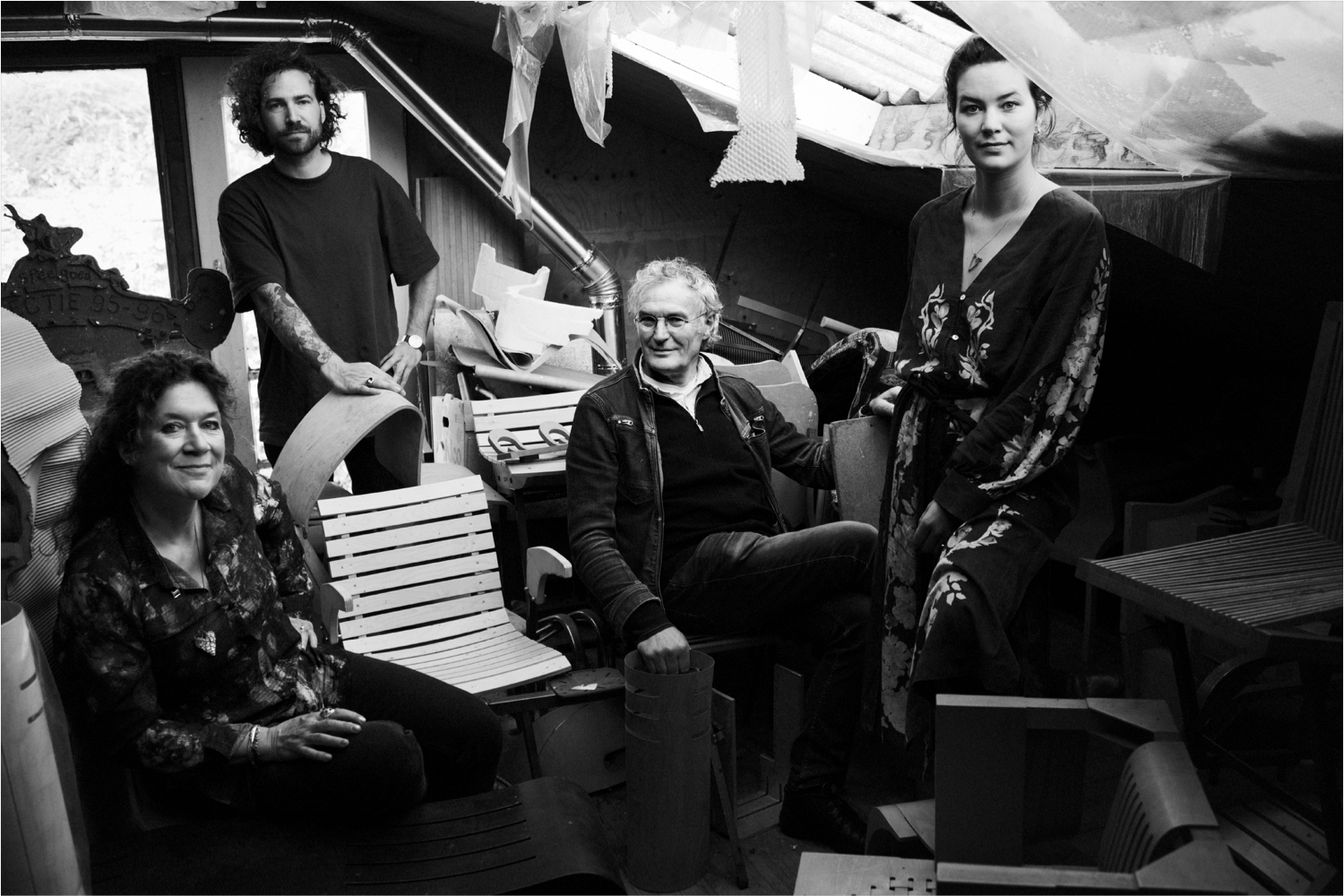
Publishers Note
Just to be clear – superfuture® is a design blog and not a political commentator. No surprise there. The scope of our content has always been global and borderless, however that can often mean covering projects in countries where we will not agree with the politics or actions of those countries. In a world that’s as screwed up as ever right now, the focus of our support is to those designers, architects and other creatives who aim to make the world a more liveable one – as opposed to people that try their hardest to destroy it. So if a project hits our desk and we like it based on its design credentials, we may choose to publish regardless of its location or creators nationality. superfuture® has always been inclusive and hopes for all current wars, aggression, violence, hate and extremism to end.


